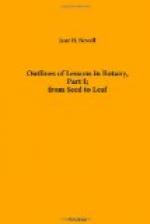[Footnote 1: The class, previously mentioned, were much interested in the addition of their results. One of them asked me whether this subject of measurements had been treated in any book. I replied that I had never seen it mentioned. My attention was afterwards called to “What may be learned from a Tree,” by Prof. Harlan Couitas. D. Appleton & Co., New York, 1863. I found, greatly to my surprise, that he had not only given diagrams of growth, but that he also had selected a Copper Beech as his example.]
The leaf-arrangement of the Beech is alternate, on the one-half plan. The small twigs turn upwards, so that all the spray is on the upper side, giving a flat appearance to the branch.[1] This gives the leaves a better exposure to the light. Both the terminal and axillary buds grow freely, thus forming long, straight limbs, with many branches and much fine spray.
[Footnote 1: Phyllotaxy is treated later, by a comparison and study of many branches, but the teacher can draw the pupils’ attention to the fact that each Beech leaf and twig is on exactly the opposite side of the branch from the preceding one. This allows all the twigs to grow towards one side of the branch, whereas in trees on the two-fifths plan, as the Apple, Poplar, Oak, etc., no such regularity would be possible, on account of their many different angles with the stem.]
The bark of the Beech is beautifully smooth. The extreme straightness of the trunk and limbs is very striking, and may be compared to the crooked limbs of the Horsechestnut, where the branch is continually interrupted by the flower-cluster. In the Beech the flowers are axillary.
QUESTIONS ON THE BEECH.
How are the scales of the Beech bud arranged?
How many leaves are there in the bud?
How does the arrangement of the scales and leaves in the bud differ from that of the Horsechestnut?
How are the leaves folded in the bud?
What is the arrangement of the leaves on the stem?
How does this differ from Horsechestnut and Lilac?
How old is your branch?
How old is each twig?
What years were the best for growth?
How does the growth of the branches differ from that
of Horsechestnut?
From Lilac?
Explain these differences with reference to the growth and arrangement of the buds?
In what direction do the twigs grow?
How does this affect the appearance of the tree?
Compare the amount of spray of the Beech and Horsechestnut and explain the reason of the difference.
These questions are only intended for review, they are never to be used for the first study of the specimen.
AMERICAN ELM (Ulmus Americana).




